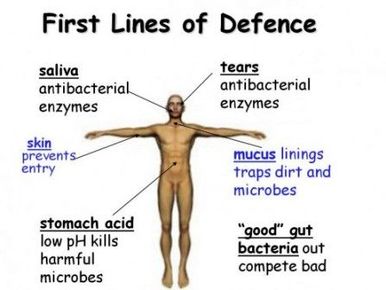
Bacteria, viruses, and other pathogens face huge resistance from the human body. The first line of defence is the skin and the linings of the eyes, mouth, nose, throat, and stomach.
Inner defences
Pathogens can enter the body through the food we eat or the air we breathe. To stop germs gaining access, internal passageways are lined with protective fluids, such as saliva, mucus and tears.
Tears
Salty tears form to wash away eye pathogens. Foreign bodies that enter the eye are washed out by tears. Moreover, tears contain a substance called lysozyme, which has an antibacterial action, and works to prevent invasion and infection by microbes. Tears contain components that heal damage to the surface of the eye.
Mucus
The nose is lined with sticky mucus to trap germs. When a sickness-causing agent like a virus or bacteria enters your body, the cells that produce mucus kick into a higher gear and pump out more of the slimy stuff, which then picks up the germs. Mucus usually clears itself out of the body as we’ve discussed, but sometimes it needs a little help. Coughing and blowing your nose are the best ways to help mucus fight the good fight.
Saliva
This slimy substance has chemicals to kill mouth bacteria. In addition to keeping your mouth healthy, saliva may contain indicators of health concerns as well. Since it shares many properties with blood, the use of saliva to detect and diagnose oral diseases and other diseases that could affect your general health is being studied. Researchers have reported promising results in the use of saliva for the diagnosis of breast cancer, oral cancers, gum disease and viral hepatitis. Saliva is already used for rapid HIV testing.
Wax
Ears contain thick wax to deter invaders. Earwax also acts as a filter. It prevents harmful things like bugs, sand and dirt from getting into our ears and to the ear drum. It’s also antimicrobial. Earwax has substances in it that prevent infections from entering the body.
Skin
The body’s outer covering is a barrier against infection. If skin is injured, the blood supply to the skin increases in order to deliver various substances to the wound so it is better protected from infections and can heal faster. Later on, new cells are produced to form new skin and blood vessels. Depending on how deep the wound is, it heals with or without a scar.
Blood
Different types of white blood cells unite to attack invaders. A lymphocyte is a type of white blood cell that is part of the immune system. There are two main types of lymphocytes: B cells and T cells. The B cells produce antibodies that are used to attack invading bacteria, viruses, and toxins. The T cells destroy the body’s own cells that have themselves been taken over by viruses or become cancerous.
Stomach
Powerful acid in the stomach destroys germs in food. The hydrochloric acid in the gastric juice breaks down the food and the digestive enzymes split up the proteins. The acidic gastric juice also kills bacteria.
Picture Credit : Google

